Show any scene from any movie, and one could easily distinguish when it is Wes Anderson’s. This is probably the reason why he is one of the most known auteurs of our times. Wes Anderson films are famous for the choice of colour, symmetry and balance and The Royal Tenenbaums is not an exception. The first part of my analysis covers the narrative and mise-en-scene of the film.
“One of the initial ideas for this movie was that it would be based on a book, a book that doesn’t actually exist,” says Anderson at a commentary. This explains why the opening shot of the film is of someone checking the book, “The Royal Tenenbaums,” out of a library. The film continues to be as a book with an epilogue, a prologue and eight chapters for eight sequences. This creates a framing story of an irregular family that reunited after twenty-two years. At the establishing sequence, the voice-over somehow reads the book to introduce the characters to the audience, giving background information about them and explaining how their lives formed to drift them apart in years. There are certain on screen titles to indicate where some events took place. All these non-diegetic instruments are there to help the audience locate themselves and have an acquaintance with all the characters.
Wes Anderson is famous for his extremely symmetric and balanced frame structure that is almost perfect for an OCD sufferer. The mise-en-scene of almost every scene is perfectly symmetric and balanced with a distinctive colour structure of costumes and props. Lines are matched with rule of thirds and every prop is carefully chosen to create a colour palette. Warm colours such as earth tones dominate indoors and all of the props are chosen and located on purpose.
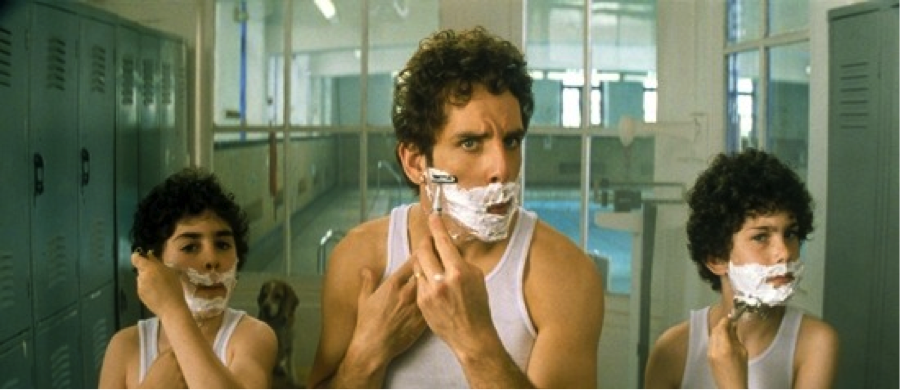

There are multiple scenes where frame within frame structure is used. This also creates a photographic image for the audience, which makes Wes Anderson movies more like visual arts than simply a way of storytelling.

Pink pants are matched with the wall, becoming invisible in order not to draw attention aside from the TV.
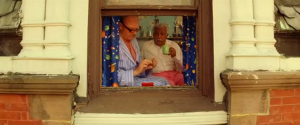
The scene is shot by using a wide angle lens to achieve greater depth of field, thus the lines are distorted.
Other than the framing structure, the use of colours is very significant in the film. In this scene, Richie is in his tent, reading Margot’s script book. The tent is mainly yellow and he is also wearing yellow, indicating the innocence. Suddenly Chas enters the tent in a nervous mood with his red tracksuit. His benign leisure time is interrupted with an alarming bright red that symbolises danger.

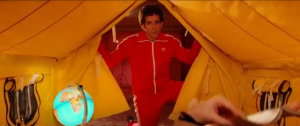
His innocent and calm leisure time is interrupted with an alarming red that comes from outside.
Anderson chose to use distinctive costumes and props for every character that will be repeated within the film. Richie always has his glasses, long beard and hair with a tennis player’s hairband. For the audience, these become more than just accessories and they are seen as the items that define Richie. That’s why it is very effective to watch him get rid of every single one of them at the scene where he attempts to commit suicide.
Margot wears a stripped dress that might be blue or red according to the mood of the scene: a passive blue when Richie committed suicide and an aggressive red before Henry reveals Royal’s lies. She always has her fur coat, the hair clip, cigarette and the gothic makeup that goes hand in hand with her dull voice tone. The props are with her since the portrayed 12-year-old Margot till the end of the film, representing her as a stable character.
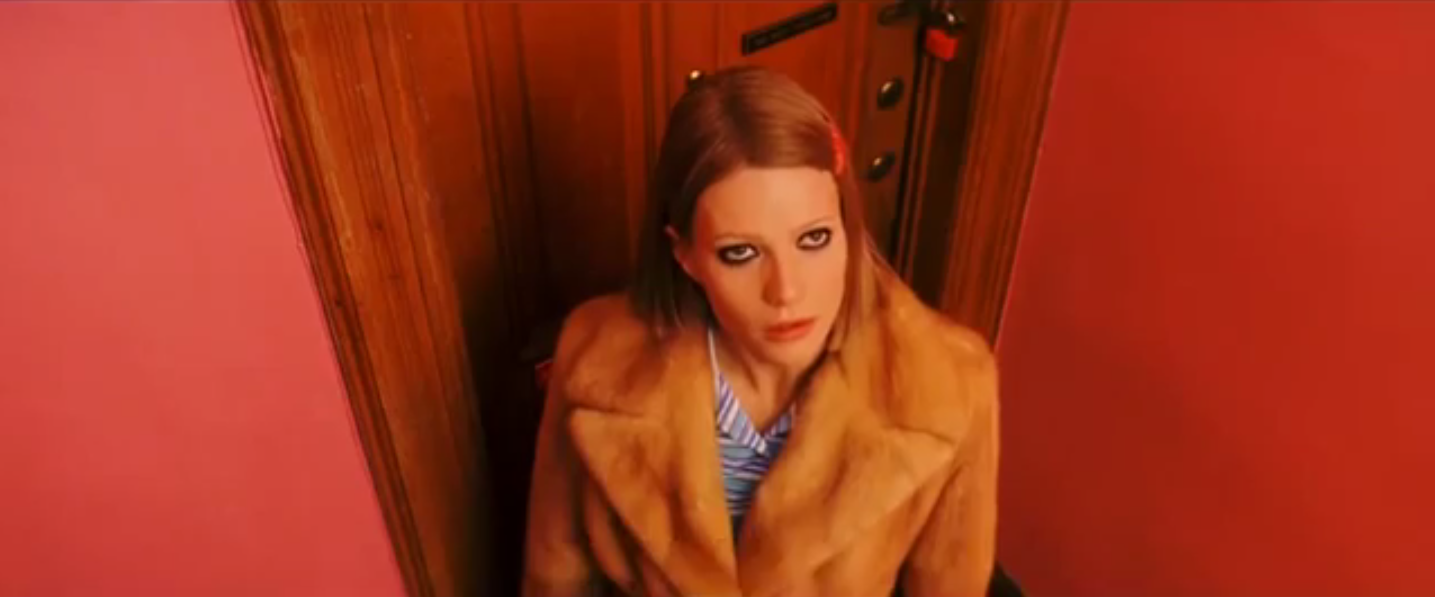
Chas and his children never take their red tracksuits off until Royal’s funeral where they wear black tracksuits. There is a powerful use of red with the character when considered that he is obsessed with security and overly concerned of any danger. The director also notes that it was so his kids could find him and each other in crowded areas.
Eli Cash has a cowboy vibe with his hat and fringed jacket. He even takes a cowboy’s rope at the end. When viewed from a western perspective, it can be interpreted as him being the outsider; the lonely hero. He admits that he always wanted to be one of the Tenenbaums, sending his reviews to Ethel with the hope that she will be proud of him.
Ethel is usually on screen with pink or lilac two piece suit and her reading glasses. With light pastel tones, she is more of a mediator and a tranquil character. Henry always has his blue jacket to imply wisdom as well as passiveness. Finally, Royal wears brown and beige which usually stands for comfort and stability, as the patriarch.
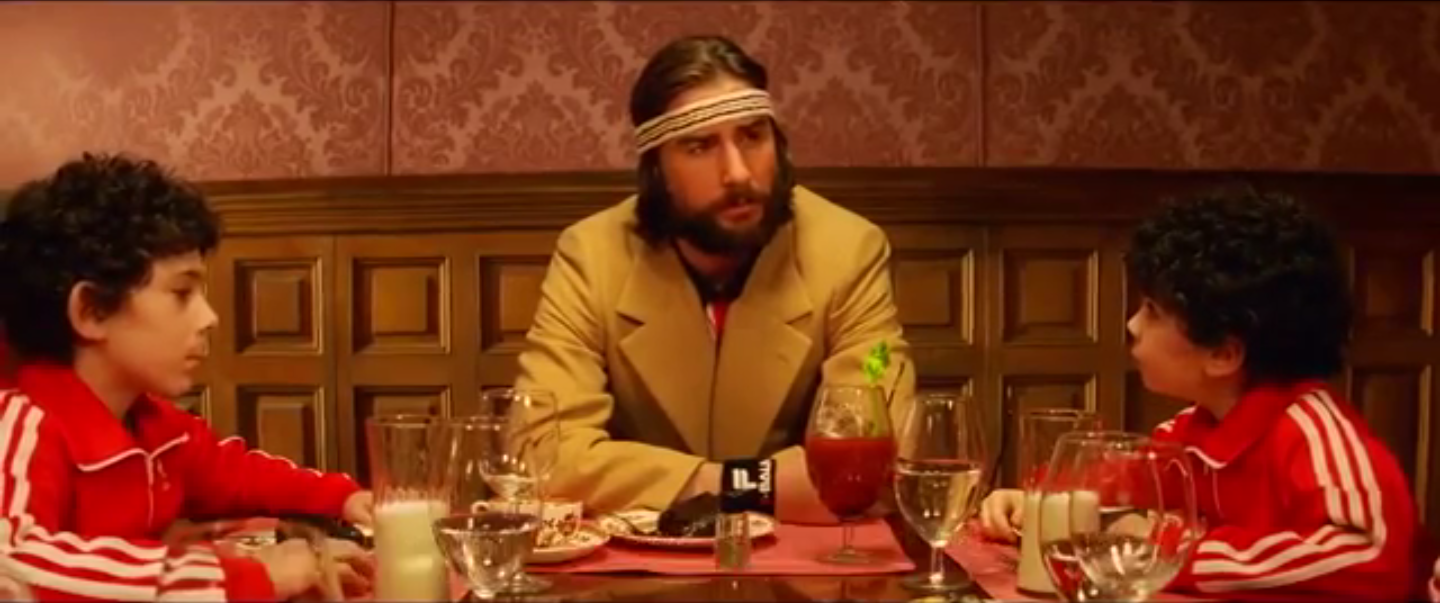
The setting is a big mansion in mainly earth tones, the comforting and embracing home to gather all members of the family after all those years. High key lighting is used almost all the time to prevent any claustrophobic shots. Chas sleeps in a sleeping bag in the boys’ room and Richie sleeps in his tent, implying that they still create their personal spaces even though they live all together. Margot has the terrace as an escaping location where she secretly smokes. The same terrace acts as a cage for Mordecai until Richie decides to set him free. The terrace acts as a “care-free zone” for the two when they smoke Margot’s ten-year-old cigarettes together.
The final aspect of mise-en-scene I want to point out is acting and performance. Also being the co-writer of The Royal Tenenbaums, Owen Wilson stars in many Wes Anderson films and his acting and performance usually brings the comic relief to the storyline. The collaboration of a director with an actor satisfies the audience when they know what to expect. The star charisma is so powerful that the audience knows that Owen Wilson will be playing a funny or mentally unbalanced Eli Cash rather than a serious one, even before the characters are introduced.
Come here if you are interested in analyzing the cinematography, editing, sound techniques and the genre of the film.
